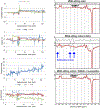Motion correction methods for MRS: experts' consensus recommendations
- PMID: 33089547
- PMCID: PMC7855523
- DOI: 10.1002/nbm.4364
Motion correction methods for MRS: experts' consensus recommendations
Erratum in
-
Motion correction methods for MRS: experts' consensus recommendations.NMR Biomed. 2022 Jan;35(1):e4644. doi: 10.1002/nbm.4644. Epub 2021 Nov 2. NMR Biomed. 2022. PMID: 34725876 No abstract available.
Abstract
Long acquisition times due to intrinsically low signal-to-noise ratio and the need for highly homogeneous B0 field make MRS particularly susceptible to motion or scanner instability compared with MRI. Motion-induced changes in both localization and shimming (ie B0 homogeneity) degrade MRS data quality. To mitigate the effects of motion three approaches can be employed: (1) subject immobilization, (2) retrospective correction, and (3) prospective real-time correction using internal and/or external tracking methods. Prospective real-time correction methods can simultaneously update localization and the B0 field to improve MRS data quality. While localization errors can be corrected with both internal (navigators) and external (optical camera, NMR probes) tracking methods, the B0 field correction requires internal navigator methods to measure the B0 field inside the imaged volume and the possibility to update the scanner shim hardware in real time. Internal and external tracking can rapidly update the MRS localization with submillimeter and subdegree precision, while scanner frequency and first-order shims of scanner hardware can be updated by internal methods every sequence repetition. These approaches are most well developed for neuroimaging, for which rigid transformation is primarily applicable. Real-time correction greatly improves the stability of MRS acquisition and quantification, as shown in clinical studies on subjects prone to motion, including children and patients with movement disorders, enabling robust measurement of metabolite signals including those with low concentrations, such as gamma-aminobutyric acid and glutathione. Thus, motion correction is recommended for MRS users and calls for tighter integration and wider availability of such methods by MR scanner manufacturers.
Keywords: MRS; Metabolites-neurochemistry; NMR probes; motion correction; navigator; optical tracking; real time; shim correction.
© 2020 John Wiley & Sons, Ltd.
Figures



References
-
- Kreis R Issues of spectral quality in clinical 1H-magnetic resonance spectroscopy and a gallery of artifacts. NMR in biomedicine. 2004;17(6):361–381. - PubMed
-
- Jenkinson M, Bannister P, Brady M, Smith S. Improved optimization for the robust and accurate linear registration and motion correction of brain images. NeuroImage. 2002;17(2):825–841. - PubMed
-
- Juchem C, Cudalbu C, de Graaf RA, et al. B0 Shimming for In Vivo Magnetic Resonance Spectroscopy: Experts’ Consensus Recommendations. Nmr Biomed. 2020:in press. - PubMed
-
- Ebel A, Maudsley AA. Detection and correction of frequency instabilities for volumetric 1H echo-planar spectroscopic imaging. Magnetic resonance in medicine. 2005;53(2):465–469. - PubMed
-
- Ogg RJ, Kingsley PB, Taylor JS. Wet, a T-1-Insensitive and B-1-Insensitive Water-Suppression Method for in-Vivo Localized H-1-Nmr Spectroscopy. Journal of Magnetic Resonance Series B. 1994;104(1):1–10. - PubMed
Publication types
MeSH terms
Substances
Grants and funding
LinkOut - more resources
Full Text Sources

